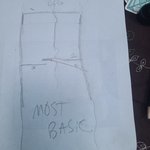That's the gist of it.
To my recollection, Gord from BC was the feller who introduced it on TB, in the relatively early days.
I've never heard it discussed outside the forums, but I don't know many people in the industry.
Cut the first side of snapcut, add a snipe (square or at an obtuse angle).
Cut second side of snapcut, as per usual, lower than the first side.
The snipe should be deep. It doesn't need to be particularly wide, unless you are trying to add 'English', in one direction/ rotation or more.
I generally make the snipe so my horizontal full-dutchman bypasses the intersections of planes by 1-2".
When chunking heavier, I'll come down 2"ish or more on the second side.
Generally, it's no-frills.
Works well when cutting well more than a bar length. I had to chunk down, without overhead TIP, a 5-6' dbh cottonwood with a single stem to about 80' (leave logs lay in the forest, thankfully). I was running an ms660 with a 36" bar. Making a hinge would have been hard. Luckily, it was a cold, wet winter that year, adding to the challenge. Needed the dollars at the time.
Helps if your chainsaw becomes a metal detector (I was in a tv antennae tree, topped doug-fir) or if you get sent up a crooked cutting saw, as you don't need much precision.
Clearly, a sharp chain is right. But sometimes you get two more chunks down and you're on the ground, so make it work.
I haven’t figured a length limit. 12' are easy for me to be judging a relatively plumb trunk's COG by sight. If you see the kerf close AT ALL, Stop on your first horizontal!
Consider crocheting density.
On a side note...
Some people will use a long wedge or stick in the kerf, inserted ay a slight angle from horizontal, lightly placed, to form a "tattle-tale". The Stick or wedge is commonly in the backcut of a standard felling cut. The faller can see small movements magnified by the length of the line/ stick/ wedge. The felling wedges being pounded are straight in the kerf, giving the feller a reference.
Start small, even practice on the ground with small spars in totally no-consequence situations.





